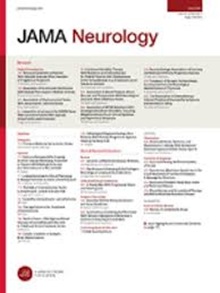GLP-1 Receptor Agonists in Idiopathic Intracranial Hypertension.
IF 21.3
1区 医学
Q1 CLINICAL NEUROLOGY
引用次数: 0
Abstract
Importance Current treatment options for idiopathic intracranial hypertension (IIH) are limited by efficacy, safety, and sustainability concerns. Glucagon-like peptide 1 receptor agonists (GLP-1 RAs), known for promoting weight loss and metabolic regulation, may offer a novel therapeutic approach. Objective To assess whether GLP-1 RA therapy is associated with improved clinical outcomes in patients with IIH compared with conventional therapies. Design, Setting, and Participants This retrospective cohort study was conducted using data from the TriNetX US Collaborative Network between 2005 and 2024, with a follow-up duration of 1 year. Electronic health records from 67 health care organizations across the United States were examined. Participants were patients 18 years and older who had IIH. Exposure Initiation of GLP-1 RA therapy within 6 months of IIH diagnosis. The control group included patients managed with conventional treatments, such as acetazolamide, topiramate, and dietary counseling, without GLP-1 RA exposure. Main Outcomes and Measures Outcomes included use of non-GLP-1 RA medication, symptoms and signs, procedures, and mortality over 1 year. Outcomes were expressed as risk ratios (RRs) with 95% CI. Results A total of 44 373 patients with IIH were identified. Before propensity score matching, the cohort included 603 GLP-1 RA users and 43 770 nonusers. The GLP-1 RA group was older (mean [SD] age, 43.2 [13.0] vs 35.5 [14.3] years; P < .001) with fewer male patients (n = 60 [10.0%] vs n = 5879 [13.5%]; P = .01) and a similar number of female patients (n = 522 [86.6%] vs n = 36 796 [84.3%]; P = .13). After matching, 555 GLP-1 RAs users were compared with 555 nonusers. GLP-1 RA use was associated with lower medication use (RR, 0.53; 95% CI, 0.46-0.61; P < .001) and reduced headaches (RR, 0.45; 95% CI, 0.35-0.58; P < .001), visual disturbances or blindness (RR, 0.60; 95% CI, 0.41-0.88; P = .007), and papilledema (RR, 0.19; 95% CI, 0.10-0.34; P < .001). Procedures (RR, 0.44; 95% CI, 0.30-0.63; P < .001) and mortality (RR, 0.36; 95% CI, 0.18-0.73; P = .003) were lower in the GLP-1 RA group, but mean (SD) body mass index (BMI) did not differ at follow-up (40.6 [9.2] vs 39.5 [8.7]; P = .10). Sensitivity analysis stratified by BMI (≥40 vs <40) showed similar associations. Bariatric surgery was associated with greater weight loss, but GLP-1 RA therapy was associated with better outcomes. Conclusions and Relevance GLP-1 RA therapy in IIH is associated with significant reductions in medication use, symptoms/signs, and procedural interventions, suggesting its potential as a management strategy. Further prospective studies are warranted to confirm these findings.GLP-1受体激动剂治疗特发性颅内高压。
目前特发性颅内高压(IIH)的治疗方案受到有效性、安全性和可持续性问题的限制。胰高血糖素样肽1受体激动剂(GLP-1 RAs)以促进减肥和代谢调节而闻名,可能提供一种新的治疗方法。目的评估与常规治疗相比,GLP-1 RA治疗是否与IIH患者的临床预后改善相关。设计、环境和参与者本回顾性队列研究采用TriNetX美国合作网络2005年至2024年的数据,随访时间为1年。研究人员检查了美国67家医疗机构的电子健康记录。参与者为18岁及以上的IIH患者。暴露:IIH诊断后6个月内开始GLP-1 RA治疗。对照组包括接受常规治疗的患者,如乙酰唑胺、托吡酯和饮食咨询,没有GLP-1 RA暴露。主要结局和测量结果包括非glp -1类风湿性关节炎药物的使用、症状和体征、治疗过程和1年内的死亡率。结果以95% CI的风险比(rr)表示。结果共筛选出44例 373例IIH患者。在倾向评分匹配之前,队列包括603名GLP-1 RA使用者和43 770名非使用者。GLP-1 RA组年龄较大(平均[SD]年龄,43.2 [13.0]vs 35.5[14.3]岁;P < 0.001),男性患者较少(n = 60 [10.0%] vs n = 5879 [13.5%];P = 0.01),女性患者人数相似(n = 522 [86.6%] vs n = 36 796 [84.3%];p = .13)。匹配后,555名GLP-1 RAs使用者与555名非使用者进行比较。GLP-1 RA的使用与较低的用药相关(RR, 0.53;95% ci, 0.46-0.61;P < 0.001),头痛减轻(RR, 0.45;95% ci, 0.35-0.58;P < 0.001)、视觉障碍或失明(RR, 0.60;95% ci, 0.41-0.88;P = .007)和乳头水肿(RR, 0.19;95% ci, 0.10-0.34;p < 0.001)。程序(RR, 0.44;95% ci, 0.30-0.63;P < 0.001)和死亡率(RR, 0.36;95% ci, 0.18-0.73;P = 0.003)低于GLP-1 RA组,但随访时平均(SD)体重指数(BMI)无差异(40.6 [9.2]vs 39.5 [8.7];p = .10)。按BMI分层的敏感性分析(≥40 vs <40)显示相似的相关性。减肥手术与更大的体重减轻相关,但GLP-1 RA治疗与更好的结果相关。结论和相关性:在IIH患者中,eglp -1 RA治疗与药物使用、症状/体征和程序性干预的显著减少相关,表明其作为一种管理策略的潜力。需要进一步的前瞻性研究来证实这些发现。
本文章由计算机程序翻译,如有差异,请以英文原文为准。
求助全文
约1分钟内获得全文
求助全文
来源期刊

JAMA neurology
CLINICAL NEUROLOGY-
CiteScore
41.90
自引率
1.70%
发文量
250
期刊介绍:
JAMA Neurology is an international peer-reviewed journal for physicians caring for people with neurologic disorders and those interested in the structure and function of the normal and diseased nervous system. The Archives of Neurology & Psychiatry began publication in 1919 and, in 1959, became 2 separate journals: Archives of Neurology and Archives of General Psychiatry. In 2013, their names changed to JAMA Neurology and JAMA Psychiatry, respectively. JAMA Neurology is a member of the JAMA Network, a consortium of peer-reviewed, general medical and specialty publications.
 求助内容:
求助内容: 应助结果提醒方式:
应助结果提醒方式:


